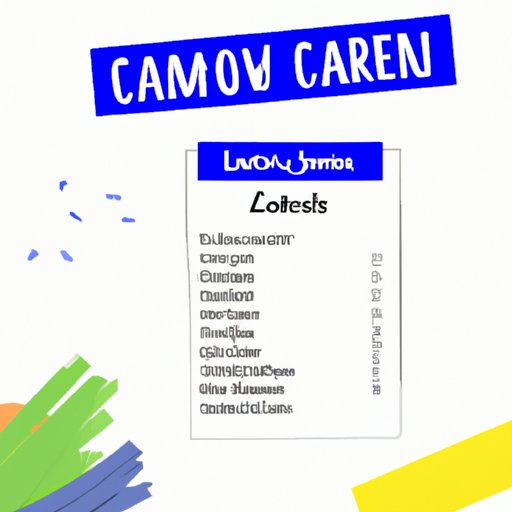Introduction
Eating low carb can be an effective way to maintain or lose weight. But what exactly does “low carb” mean? According to the National Institutes of Health, a low-carb diet is one that contains fewer than 130 grams of carbohydrates per day. This type of eating plan can help you manage your weight, improve your blood sugar levels, and reduce your risk of chronic diseases like diabetes and heart disease.
Create a Meal Plan
Creating a meal plan is a great way to start eating low carb. Here are some tips for getting started:
Identify Your Goals
Before you begin, it’s important to know why you’re eating low carb. Are you trying to lose weight or improve your overall health? Knowing your goals will help you create a meal plan that’s tailored to your needs.
Choose Low-Carb Recipes
Once you’ve identified your goals, it’s time to start looking for recipes. Look for recipes that feature lean proteins, non-starchy vegetables, and healthy fats. You could also try swapping out higher-carb ingredients for lower-carb alternatives. For example, use cauliflower instead of white rice or zucchini noodles instead of regular pasta.
Consider Snacks
Snacking can be part of a healthy low-carb diet. When choosing snacks, opt for items that are high in fiber, protein, and healthy fats. Some good low-carb snack ideas include nuts, seeds, hard-boiled eggs, jerky, and nut butter. Just be sure to watch your portion sizes.
Shop Smartly
When shopping for low-carb foods, it’s important to read nutrition labels carefully. Here are some tips for shopping smartly:
Read Nutrition Labels
Before you buy any food item, check the nutrition label for information about its carbohydrate content. If the label states that a product has more than 5 grams of carbs per serving, it might not be the best option. Also look for products that are higher in fiber and protein, as these can help you feel full for longer.
Select Foods with Fewer Carbs
When selecting foods, choose items that have fewer carbohydrates. Look for fresh fruits and vegetables that are naturally low in carbs, such as leafy greens, broccoli, cauliflower, tomatoes, and cucumbers. As for proteins, opt for lean cuts of meat, fish, and poultry, as well as plant-based proteins like tofu, tempeh, and legumes.
Include Protein
Incorporating plenty of protein into your meals is essential when following a low-carb diet. Here are some tips for including protein in your meals:
Choose Lean Proteins
When selecting proteins, opt for lean cuts of meat, fish, and poultry. Examples include skinless chicken breast, ground turkey, salmon, and tuna. These foods are rich in protein and contain few carbs.
Consider Plant-Based Proteins
If you don’t eat animal products, there are still plenty of options for getting enough protein. Plant-based proteins like beans, lentils, tofu, tempeh, and quinoa are great sources of protein. They’re also rich in other important nutrients like fiber, iron, and magnesium.
Increase Vegetables
Vegetables are an important part of a low-carb diet. Here are some tips for including more veggies in your meals:
Choose High-Fiber Veggies
Fiber helps keep you full and can help prevent spikes in blood sugar. High-fiber vegetables include broccoli, Brussels sprouts, spinach, kale, squash, and cauliflower. Aim to get at least three servings of veggies per day.
Find Low-Carb Options
Not all vegetables are created equal when it comes to carbs. Some veggies are higher in carbs than others. Examples of low-carb veggies include tomatoes, peppers, mushrooms, cucumbers, and celery.
Limit Refined Carbs
Refined carbs like white bread, pasta, and pastries can be high in calories and low in nutrients. Here’s how to limit these types of carbs:
Avoid White Bread and Pasta
White bread, pasta, and other refined grains can be high in carbs and low in fiber. To reduce your intake of refined carbs, opt for whole wheat bread and brown rice instead.
Look for Whole Grains
Whole grains are an excellent source of fiber, which can help keep you feeling full for longer. Examples of whole grains include oats, quinoa, farro, and barley. Be sure to read nutrition labels to make sure the product you’re buying is made from 100% whole grains.
Snack Wisely
Snacking can be part of a healthy low-carb diet. Here are some tips for snacking wisely:
Choose Healthy Snacks
When choosing snacks, opt for items that are high in fiber, protein, and healthy fats. Some good low-carb snack ideas include nuts, seeds, hard-boiled eggs, jerky, and nut butter.
Monitor Serving Sizes
It’s important to watch your portion sizes when snacking. Even healthy snacks can be high in calories if you eat too much. To stay on track with your low-carb diet, measure out single servings of snacks before eating them.
Conclusion
Eating low carb can be a great way to manage your weight and improve your overall health. To get started, create a meal plan that includes lean proteins, non-starchy vegetables, and healthy fats. When shopping, read nutrition labels carefully and select foods that are higher in fiber and protein. And when snacking, opt for items that are high in fiber, protein, and healthy fats. With a little planning and preparation, you can easily follow a low-carb diet.
By following these tips, you can enjoy the many benefits of low-carb eating, including improved blood sugar control, weight loss, and reduced risk of chronic disease.
(Note: Is this article not meeting your expectations? Do you have knowledge or insights to share? Unlock new opportunities and expand your reach by joining our authors team. Click Registration to join us and share your expertise with our readers.)
